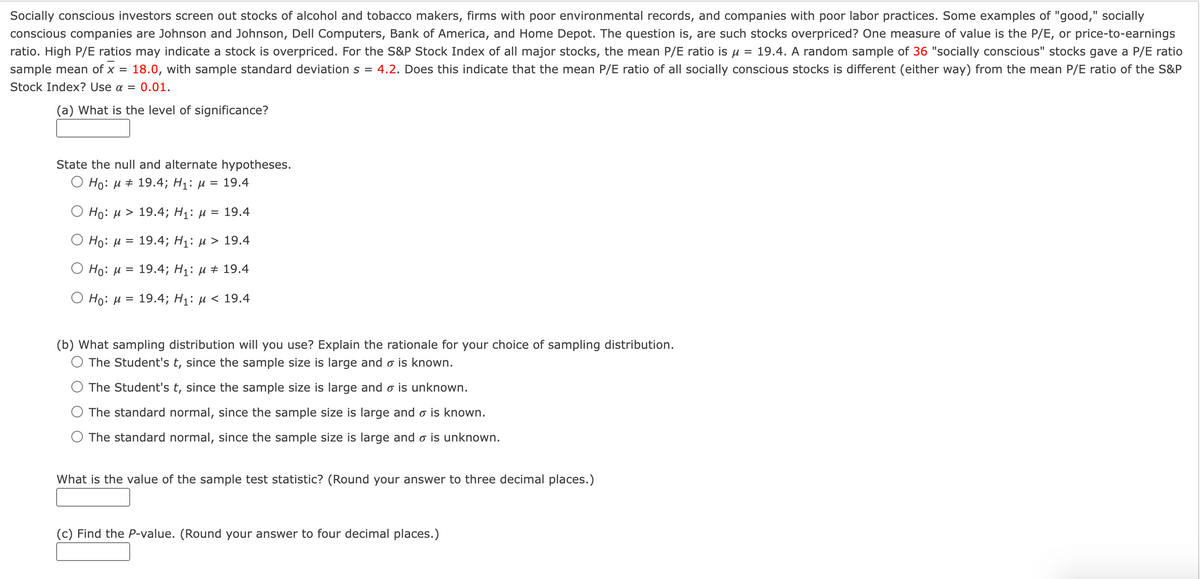Socially conscious investors screen out stocks of alcohol and tobacco makers, firms with poor environmental records, and companies with poor labor practices. Some examples of "good," socially conscious companies are Johnson and Johnson, Dell Computers, Bank of America, and Home Depot. The question is, are such stocks overpriced? One measure of value is the P/E, or price-to-earnings ratio. High P/E ratios may indicate a stock is overpriced. For the S&P Stock Index of all major stocks, the mean P/E ratio is u = 19.4. A random sample of 36 "socially conscious" stocks gave a P/E ratio sample mean of x = 18.0, with sample standard deviation s = 4.2. Does this indicate that the mean P/E ratio of all socially conscious stocks is different (either way) from the mean P/E ratio of the S&P Stock Index? Use a = 0.01. (a) What is the level of significance? State the null and alternate hypotheses. O Họ: u + 19.4; H1: µ = 19.4 Ο Hg: μ >19.4 ; H: μ= 19.4 O Họ: u = 19.4; H1: µ > 19.4 Ο Hρ: μ 19.4; Η: μ+ 19.4 Ο H0: μ= 19.4; H: μ < 19.4 (b) What sampling distribution will you use? Explain the rationale for your choice of sampling distribution. O The Student's t, since the sample size is large and o is known. O The Student's t, since the sample size is large and o is unknown. O The standard normal, since the sample size is large and o is known. O The standard normal, since the sample size is large and o is unknown. What is the value of the sample test statistic? (Round your answer to three decimal places.) (c) Find the P-value. (Round your answer to four decimal places.)
Socially conscious investors screen out stocks of alcohol and tobacco makers, firms with poor environmental records, and companies with poor labor practices. Some examples of "good," socially conscious companies are Johnson and Johnson, Dell Computers, Bank of America, and Home Depot. The question is, are such stocks overpriced? One measure of value is the P/E, or price-to-earnings ratio. High P/E ratios may indicate a stock is overpriced. For the S&P Stock Index of all major stocks, the mean P/E ratio is u = 19.4. A random sample of 36 "socially conscious" stocks gave a P/E ratio sample mean of x = 18.0, with sample standard deviation s = 4.2. Does this indicate that the mean P/E ratio of all socially conscious stocks is different (either way) from the mean P/E ratio of the S&P Stock Index? Use a = 0.01. (a) What is the level of significance? State the null and alternate hypotheses. O Họ: u + 19.4; H1: µ = 19.4 Ο Hg: μ >19.4 ; H: μ= 19.4 O Họ: u = 19.4; H1: µ > 19.4 Ο Hρ: μ 19.4; Η: μ+ 19.4 Ο H0: μ= 19.4; H: μ < 19.4 (b) What sampling distribution will you use? Explain the rationale for your choice of sampling distribution. O The Student's t, since the sample size is large and o is known. O The Student's t, since the sample size is large and o is unknown. O The standard normal, since the sample size is large and o is known. O The standard normal, since the sample size is large and o is unknown. What is the value of the sample test statistic? (Round your answer to three decimal places.) (c) Find the P-value. (Round your answer to four decimal places.)
Glencoe Algebra 1, Student Edition, 9780079039897, 0079039898, 2018
18th Edition
ISBN:9780079039897
Author:Carter
Publisher:Carter
Chapter10: Statistics
Section10.6: Summarizing Categorical Data
Problem 4BGP
Related questions
Question

Transcribed Image Text:Socially conscious investors screen out stocks of alcohol and tobacco makers, firms with poor environmental records, and companies with poor labor practices. Some examples of "good," socially
conscious companies are Johnson and Johnson, Dell Computers, Bank of America, and Home Depot. The question is, are such stocks overpriced? One measure of value is the P/E, or price-to-earnings
ratio. High P/E ratios may indicate a stock is overpriced. For the S&P Stock Index of all major stocks, the mean P/E ratio is u = 19.4. A random sample of 36 "socially conscious" stocks gave a P/E ratio
sample mean of x =
18.0, with sample standard deviation s = 4.2. Does this indicate that the mean P/E ratio of all socially conscious stocks is different (either way) from the mean P/E ratio of the S&P
Stock Index? Use a =
0.01.
(a) What is the level of significance?
State the null and alternate hypotheses.
О Но: и # 19.4;B Hi: и %3D 19.4
O Ho: µ > 19.4; H1: µ = 19.4
O Ho: H
3D 19.4;B Hi: и > 19.4
O Ho: H
3D 19.4; H1: и # 19.4
O Ho: µ =
19.4; Hi: и < 19.4
(b) What sampling distribution will you use? Explain the rationale for your choice of sampling distribution.
O The Student's t, since the sample size is large and o is known.
O The Student's t, since the sample size is large and o is unknown.
O The standard normal, since the sample size is large and o is known.
O The standard normal, since the sample size is large and o is unknown.
What is the value of the sample test statistic? (Round your answer to three decimal places.)
(c) Find the P-value. (Round your answer to four decimal places.)
Expert Solution
This question has been solved!
Explore an expertly crafted, step-by-step solution for a thorough understanding of key concepts.
Step by step
Solved in 4 steps

Recommended textbooks for you

Glencoe Algebra 1, Student Edition, 9780079039897…
Algebra
ISBN:
9780079039897
Author:
Carter
Publisher:
McGraw Hill

Glencoe Algebra 1, Student Edition, 9780079039897…
Algebra
ISBN:
9780079039897
Author:
Carter
Publisher:
McGraw Hill